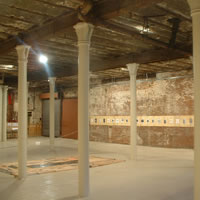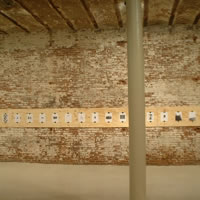
Main Space
David Hammons: The Unauthorized Retrospective (January 8 - February 12, 2006)
Four years in the making, "David Hammons: The Unauthorized Retrospective" is the first survey of the artist's work since 1991, and the most comprehensive assembly ever either in exhibition or book form. The exhibition, which includes none of the artist's actual art, consists of photocopies and computer print-outs of nearly 100 body-prints, sculptures, drawings, performances, and installations dating from the mid-1960s to the present.
David Hammons (b. 1943) is an art-world trickster. For more than forty years, he has used the conventions of the art world against itself, making work that profoundly questions the role of art in society. His work draws on artistic precedents such as arte povera, Duchampian appropriation, African sculpture, and Outsider art, as well as jazz, bebop, and more vernacular forms of expression like braiding and weaving. It not only captures the spirit and some aspect of African American culture, it is fashioned from its detritus: urbian grit, bottle caps, chicken bones, hair, brown bags, sneakers, basketballs, musical instruments, and other materials. Hammons has consistently validated the aesthetics of the street over those of the white cube. His work can be simultaneously sincere and tongue-in-cheek, and it is the viewer's inability to determine when he is being one or the other that makes him and his work so enigmatic.
The origins of "David Hammons: The Unauthorized Retrospective" date back to the fall of 2001. Even before opening to the public, Triple Candie tried to interest Hammons in creating a new installation in its 5,000 square foot Main Space. By 2004, after several attempts, it was clear that working with the artist directly would be impossible, so Triple Candie tried to curate a show of existing work, but collectors and dealers who are close to the artist were unwilling to cooperate without Hammons' permission. (Mr. Hammons prefers to control access to his work, even after it leaves his studio.) In response to this situation, Triple candie decided to showcase the artist's extraordinary legacy by organizing an exhaustive retrospective on its own terms.
The exhibition includes color copies, black & white copies, and color computer printouts taken from existing reproductions in exhibition catalogues, brochures, and websites. The copies have been trimmed and mounted on 8 1/2 x 11 in. sheets of copy paper, and installed in chronological order.
The exhibition is accompanied by a catalogue that includes black & white reproductions made directly from the copies in the exhibition. The poor quality of the reproductions is intentional. Many of them are partially or completely undecipherable because they are several generations away from the original source. Additionally, the catalogue contains Xeroxes of three previously published interviews with the artists. Any imperfections resulting from the copying process -- such as tonal gradations caused because a book could not be laid flat on the copier's glass -- have been preserved. This has resulted, on occasion, in the illegibility of the texts.
On one level, this exhibition is about David Hammons, his art, and his career. The artist and his oeuvre are enshrouded in mystery and the lack of monographs on his work (there is only one: Rousing the Rubble, 1991) has served to amplify this condition. On another, it is about the art world: particularly, how the strategic process of ascribing value to an artist's work -- by galleries, collectors, curators, even artists -- changes the art's relationship to the public. Finally, this collection of reproductions is meant to question the status quo of exhibition-making itself. By going through the efort to present an artist's work in this way, Triple Candie attempts to show the inherent absurdity and many retrospectives, which are usually hagiographic enterprises that seek to minimize any true critical investigation of their subjects.
David Hammons has lived an worked in Harlem since the mid-1970s. He has had solo exhibitions at Hauser & Wirth, Zurich (2003), White Cube, London (2002), ACE Gallery, New York (2002), Gallery Shimada, Yamaguchi, Japan (2001 and 1998), Museo Reina Maria Sophia, Madrid (2000), Kunsthalle Bern (1998), Salzburger Kunstverein Salzburg (1995), Williams College Art Center, Williamstown, Massachusetts (1993), American Academy in Rome (1992), Jack Tilton Gallery (1991 and 1990), Exit Art (1989), Just Above Midtown Gallery (1986, 1976, and 1975), and the Museum of Contemporary Art (1980). Recently, his work was included in group exhibitions at Dak'art Biennial in Senegal, Museum of Modern Art, Baltimore Museum of Art, Des Moines Art Center, Bronx Museum of the Arts, Rhode Island School of Design, Walter Art Center, Bronx Museum of the Arts, Rhode Island School of Design, Walker Art Center. His public commissions include the Atlanta International Airport, Public Art Fund, Creative Time, and Spoleto Arts Festival. He studied at Otis Art Institute and the Chouinard Art Institute (now CalArts).
Credits: The curators would like to thank the library staff at the Museum of Modern Art for assistance with the research for this exhibition.







